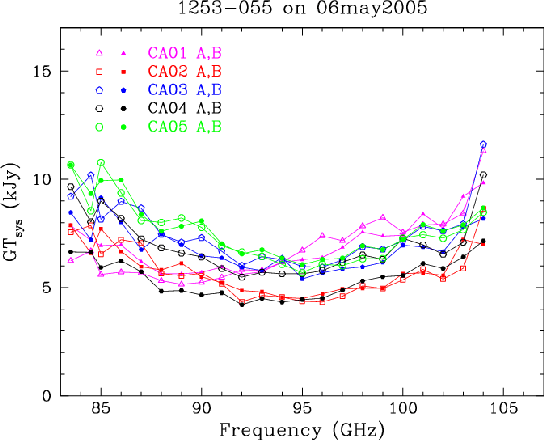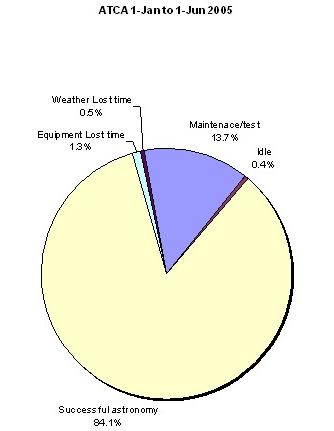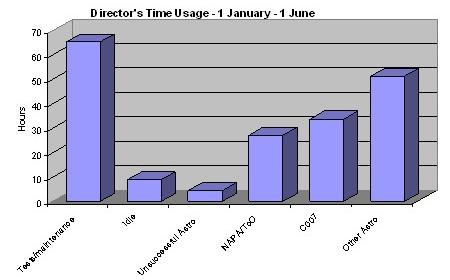Compact Array and Mopra report
3-mm developments
Since the end of the 2004 millimetre season, substantial progress has been made on improving the overall functionality of the 3-mm system.
As mentioned in the last newsletter, a problem of low gain on antenna CA01 has been resolved. During March, axial and lateral adjustments have been made to optimise the subreflector position on a number of antennas. Partly driven by work for NASA, the so-called "second derivative" problem of the phase rotators (a problem that has been known for many years) has at last been properly understood and resolved. Subsequent measurements of the local oscillator stability show that it is excellent (less than 3 degrees rms phase noise at 86 GHz). With all five antennas now showing good gain, reference pointing is now much more robust.
On the hardware side, a new 3-mm low-noise amplifier was installed into one antenna (CA04 channel B). This is now by far the best receiver in the system, with system temperatures as low as 170K. Amplifiers in the millimetre conversion chain have also been replaced. This has helped to make the power across the system more uniform, and to make the system temperature measurement scheme (paddle calibration) more robust.

Figure 1: Compact Array system sensitivity at 3 mm.
Figure 1 (with thanks to Tony Wong) shows the system sensitivity of the 3-mm receivers across the band. As can be seen, the best sensitivity is at 93 – 95 GHz.
On the operational side, the flux densities of about 120 "bright" 3-mm calibrators were re-measured in May. These measurements have been included within the Compact Array calibrator web search engine. During the 2005 season the flux density of the calibrators 1921-293 and 1253-055 will be measured, on a monthly basis, using Mars and Uranus as primary flux standards. As a consequence it will be possible for a number of observing projects to use 1921-293 and 1253-055 as flux standards rather than the planets.
During February and March, the seeing monitor was modified to improve the unit's cooling. This is back in service, with the output also available on the web.
There are still a number of avenues being worked on to improve the utility of the 3-mm systems. These include better understanding of some instrumental phase errors, installing an opacity meter, improved pointing models, understanding gain/elevation effects (these may have a temperature dependence), as well as enhancements to the on-line and off-line software.
Other developments
The Compact Array Linux observing system is largely complete and is now in a "friendly user" testing phase. It is anticipated that the Observatory will switch from the VAX systems to this in July or August. If you are at Narrabri, we invite you to volunteer to try the new system.
Installation of the second 16-MHz filter system is on track to be ready for use during July.
Operations
 Figure 2: Usage statistics for the Compact Array
Figure 2: Usage statistics for the Compact Array to 1 June 2005.
Usage statistics for the period 1 January 1 June are given in Figure 2. In addition to normal scheduled astronomy time, a portion of Compact Array time is left as "Director's Time" in the final schedule. This is a combination of small gaps that could not be reasonably scheduled and some longer periods that are specifically set aside to give some flexibility with NAPAs, ToOs and replacement time requests. In the five months to 1 June, 5.5% of array time was marked as Director's Time. The breakdown of usage of this time is given in Figure 3. C007 is a long-running program to monitor Compact Array calibrators; this is run as a filler project when there are no other requests.
Building work
Funding has been approved for a major refurbishment of the Narrabri Control Building. An architectural firm is currently producing initial designs for discussion. The indicative plan is for detailed designs to be started in July, tender documents to be distributed late in 2005 for construction, and for construction to start in mid-2006.
At the same time, funding appears likely to upgrade the Narrabri Lodge. Planning for this is also at an initial design phase. The work on this would be anticipated to start late in 2005.
 Figure 3: Director's time usage for the Compact Array to 1 June 2005
Figure 3: Director's time usage for the Compact Array to 1 June 2005
Mopra
Mopra remains an area of significant development. During 2005 we expect to replace the front-end, the back-end, the control software and the network link.
Porting of the Mopra observing system to a LINUX environment is progressing well, thanks to the efforts of Mike Kesteven, Euan Troup and Mark Calabretta. However, there are still a few issues that need to be addressed.
Replacing the Mopra 3-mm SIS receiver with a "Compact Array-style" MMIC receiver is a part of the MNRF-1997 program. Following the successful installation of the 3-mm systems at the Compact Array in 2004, it was intended that the Mopra receiver would be ready for the 2005 season. Unfortunately this has been delayed until September 2005 and the SIS system will be used until then.
Work on the new MMIC system for Mopra is proceeding well. This receiver will benefit from several improvements in the design over the Compact Array receivers installed in September 2004. In particular, broader-band low noise amplifiers are being used, and the local oscillator design avoids some issues apparent with the Compact Array 3-mm receivers. Additionally radio frequency gain equalisation is being included in the signal path to assist in sideband separation. The receiver is expected to have good performance between 85 and 115 GHz. Because tuning is not required for the receiver, there will be significant time savings for observers in configuring the receiver. Additionally one of the polarisations will not need to be sacrificed to observe SiO for pointing. The system temperature, however, is expected to be poorer than the existing SIS system.
A complement to the new receiver is the new digital filterbank bankend, called MOPS. Ultimately MOPS will consist of four 2-GHz segments that can be configured to observe several spectral lines simultaneously within an 8-GHz window. This, combined with Mopra's on-the-fly mapping capability, will make Mopra an excellent survey instrument. It is hoped that initially one 2-GHz segment segment will be available for installation in September. Only one zoom mode, at 64-MHz bandwidth, is likely in the first instance. It is intended that all segments will be available for the 2006 millimetre-season. As an interim measure, the so-called POCS system (a proof-of-concept system for MOPS) will be installed at Mopra in July to support some projects.
Another development project at Mopra has been to implement remote operation. This development has focused on gaining robust and reliable primary monitoring and control of the Mopra systems. Work on this is now largely complete. However remote operation of Mopra will not be possible until the MMIC system is installed (tuning of the SIS system requires the observer to be at Mopra) and a faster network link is available. Both of these should be achieved by September.
Mopra induction weekend
Figure 4: Juergen Ott giving a tutorial at the Mopra workshop.
Photo: Bob Sault
The annual Mopra Induction Weekend was held on 27 – 29 May. This workshop is devoted to introducing people to the science and techniques of 3-mm astronomy, along with practical information on how to make best use of the Mopra telescope. The weekend included a series of talks, tutorials and practical sessions, plus a dinner at Skywatch Observatory. Participants came from Bonn, Swinburne, Macquarie University, UNSW and ATNF. In total, 24 people attended the weekend. Thanks to all those who made it a very successful weekend.
Finally, those who observe at Mopra will notice that it has already undergone a minor facelift, with new carpets and paint, and a rationalisation of the Mopra office.
Bob Sault
Officer-in-Charge, Narrabri Observatory
(Bob.Sault@csiro.au)
